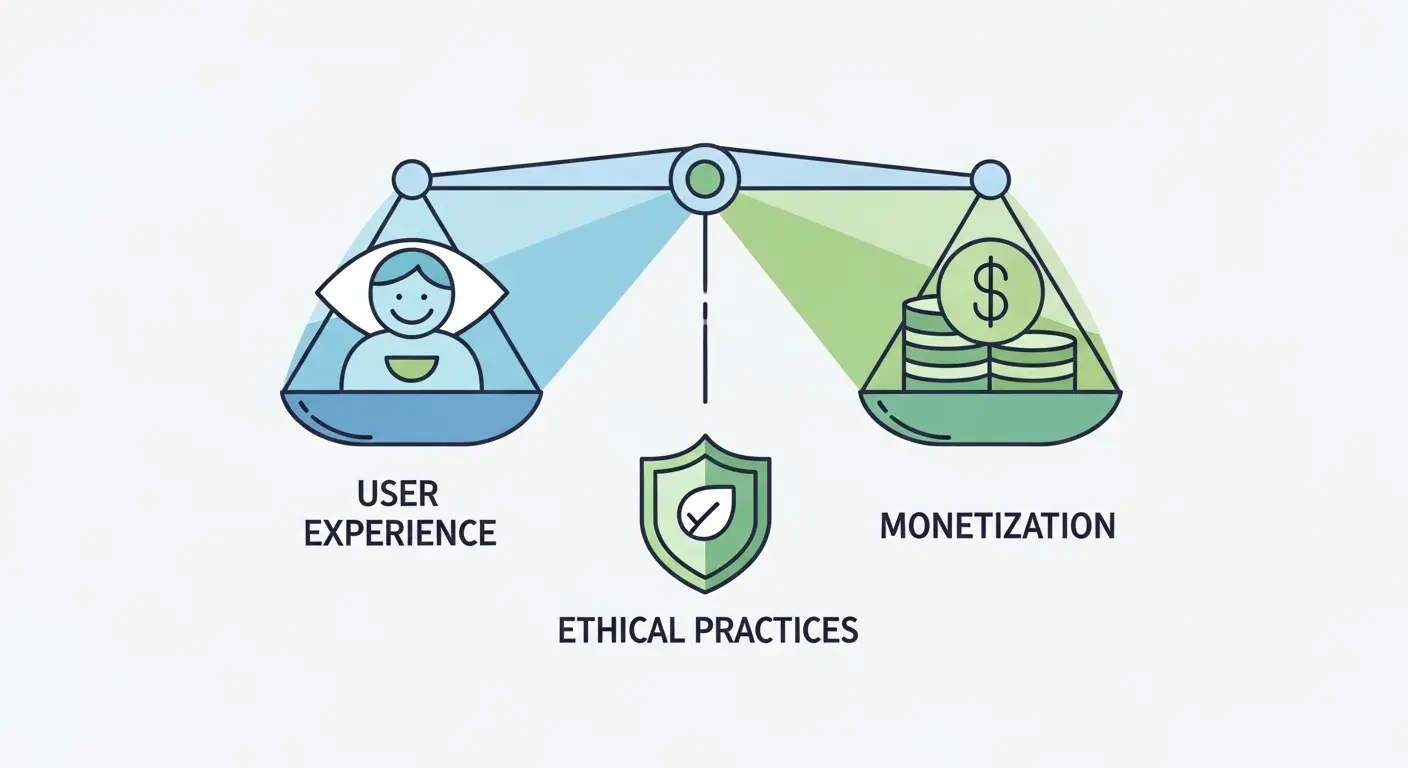Native Advertising Integration: Balancing Revenue and User Experience in 2025
Native advertising has evolved from a controversial monetization tactic to a sophisticated revenue stream that, when implemented correctly, can increase engagement rates by 60% while maintaining user trust and editorial integrity. As we move into 2025, publishers face the challenge of integrating native ads that provide genuine value to readers while generating sustainable revenue.
Understanding Native Advertising in the Modern Context
Native advertising refers to paid content that matches the form, feel, and function of the platform on which it appears. Unlike traditional display ads that interrupt the user experience, native ads blend seamlessly with editorial content, creating a more organic discovery experience for readers.
The native advertising market has grown significantly, with spending expected to reach $98.6 billion in 2025, representing over 65% of total display ad spending. This growth reflects both advertiser preference for less intrusive formats and publisher success in monetizing content without compromising user experience.
The Evolution of Native Advertising
Native advertising has matured considerably since its early days. What started as simple "sponsored content" labels has evolved into sophisticated content marketing integrations that provide real value to audiences. Modern native advertising encompasses:
- In-Feed Native Ads: Content recommendations that appear within article feeds
- Sponsored Content: Long-form articles created in partnership with brands
- Content Recommendation Widgets: "You might also like" sections powered by native ad networks
- Branded Content Partnerships: Co-created content that serves both editorial and commercial purposes
The Business Case for Native Advertising
Publishers implementing native advertising strategically report significant revenue benefits. Native ads typically generate 2-3x higher click-through rates compared to traditional display ads, with engagement rates reaching 60% higher than banner ads.
Revenue Performance Metrics
Well-executed native advertising campaigns deliver impressive results:
- Higher CPMs: Native ad placements command 20-40% higher CPMs than standard display ads
- Better Viewability: Native ads achieve 53% viewability compared to 40% for display ads
- Increased Time on Site: Users spend 20-30% more time on pages with native content
- Lower Ad Blocking: Native ads experience 90% less ad blocking than traditional formats
These metrics translate directly to revenue. Publishers with mature native advertising programs report that native ads contribute 25-40% of total digital advertising revenue, making it a critical component of diversified monetization strategies.
Native Ad Implementation Best Practices
Successful native advertising requires careful planning and execution. Publishers must balance commercial objectives with editorial standards and user experience considerations.
1. Content-First Approach
The foundation of effective native advertising is quality content. Native ads should provide genuine value to readers, not just promotional messaging. This means:
Creating Valuable Content: Native ads should educate, entertain, or inform readers. The best native content answers questions, solves problems, or provides insights that readers actively seek.
Matching Editorial Quality: Sponsored content should meet the same editorial standards as your regular content. Poor-quality native ads damage both advertiser ROI and publisher credibility.
Audience Alignment: Native content must resonate with your audience's interests and needs. Use audience data and analytics to ensure sponsored content aligns with reader preferences.
2. Transparency and Disclosure Requirements
Clear disclosure is both an ethical imperative and a legal requirement. The FTC requires that native advertising be clearly and conspicuously identified as advertising.
Disclosure Best Practices:
- Use clear labels like "Sponsored," "Paid Content," or "Advertisement"
- Place disclosures prominently at the top of content
- Avoid ambiguous terms like "Promoted" or "Presented by"
- Ensure disclosures are visible on all devices and screen sizes
- Maintain consistent disclosure practices across all native ad formats
Transparency builds trust. Research shows that 54% of consumers trust clearly labeled sponsored content, while deceptive practices can permanently damage publisher credibility.
3. Design Consistency with Editorial Content
Native ads should match your site's design language while remaining distinguishable as sponsored content. This balance is crucial for maintaining user trust while ensuring ads perform effectively.
Visual Integration Guidelines:
- Use similar typography, colors, and layout patterns as editorial content
- Maintain consistent spacing and visual hierarchy
- Apply subtle visual cues (like background tints or border treatments) to distinguish sponsored content
- Ensure mobile responsiveness matches your editorial mobile experience
- Test different design treatments to optimize both user experience and performance
4. Strategic Placement and Frequency
Where and how often native ads appear significantly impacts both user experience and revenue performance.
Optimal Placement Strategies:
- In-Feed Placements: Insert native ads every 3-5 editorial articles in content feeds
- End-of-Article Recommendations: Place content recommendation widgets after article conclusions
- Category-Specific Placements: Match native ad topics to content categories for higher relevance
- Homepage Integration: Feature 1-2 native ad units on homepage without overwhelming editorial content
Avoid oversaturation. Publishers who maintain a 70/30 or 80/20 ratio of editorial to sponsored content report better long-term engagement and revenue performance.
Revenue Optimization Strategies
Maximizing native advertising revenue requires ongoing optimization and strategic partner management.
Premium Native Ad Placement Strategies
Not all placements are created equal. Premium placements command higher CPMs and deliver better results for advertisers:
High-Value Placement Characteristics:
- Above-the-fold visibility on high-traffic pages
- Integration within popular content categories
- Placement in email newsletters and push notifications
- Featured positions in mobile apps
- Contextual relevance to surrounding content
Publishers should implement tiered pricing for native ad placements based on visibility, engagement metrics, and audience quality. Premium placements can command 3-5x higher rates than standard positions.
Sponsored Content Development Workflows
Efficient sponsored content production requires clear processes and workflows:
Content Creation Process:
- Brief Development: Work with advertisers to define objectives, key messages, and success metrics
- Editorial Review: Ensure content meets editorial standards and audience expectations
- Production: Create content using in-house editorial resources or specialized content studios
- Approval Cycles: Establish clear approval processes with defined timelines
- Publication and Promotion: Publish content and amplify through owned channels
- Performance Reporting: Provide detailed analytics to demonstrate campaign effectiveness
Many successful publishers have established dedicated content studios that specialize in creating sponsored content, ensuring consistent quality and efficient production.
Native Ad Network Optimization
Most publishers work with multiple native ad networks to maximize fill rates and revenue. Popular networks include:
- Taboola: Content discovery platform with extensive advertiser demand
- Outbrain: Premium content recommendation network
- Revcontent: Performance-focused native ad network
- Nativo: In-feed native advertising platform
- TripleLift: Native programmatic advertising solution
Network Optimization Strategies:
- Implement header bidding for native ad units to maximize competition
- Test multiple networks simultaneously to identify top performers
- Negotiate exclusive placements for premium inventory
- Monitor quality scores and block low-quality advertisers
- Optimize refresh rates and lazy loading for better performance
Cross-Platform Native Advertising Coordination
Native advertising should extend across all your digital properties for maximum revenue impact:
Multi-Platform Strategy:
- Website: In-feed ads, sponsored content, content recommendation widgets
- Mobile App: Native in-app advertising with app monetization best practices
- Email Newsletters: Sponsored newsletter sections and dedicated sponsor messages
- Social Media: Sponsored social posts and influencer partnerships
- Podcasts: Native audio advertising and sponsor integrations
Coordinated cross-platform campaigns command premium pricing and deliver better results for advertisers, creating opportunities for larger, more lucrative partnerships.
Performance Tracking and Optimization
Data-driven optimization is essential for maximizing native advertising revenue while maintaining user experience.
Key Performance Indicators
Track these metrics to evaluate native advertising performance:
Revenue Metrics:
- Native ad revenue per thousand pageviews (RPM)
- Native ad CPM by placement and format
- Fill rate for native ad units
- Revenue contribution percentage
Engagement Metrics:
- Click-through rate (CTR) for native ads
- Time spent on sponsored content
- Scroll depth and content completion rates
- Social sharing and engagement
User Experience Metrics:
- Bounce rate on pages with native ads
- Overall session duration
- Pages per session
- Return visitor rate
A/B Testing and Experimentation
Continuous testing helps optimize native advertising performance:
Testing Priorities:
- Placement Testing: Compare performance of different native ad positions
- Frequency Testing: Test optimal ratios of editorial to sponsored content
- Design Testing: Experiment with visual treatments and disclosure styles
- Format Testing: Compare in-feed ads vs. content recommendation widgets
- Network Testing: Evaluate performance across different native ad networks
Implement a structured testing program using ad layout optimization tools to systematically improve performance.
Analytics and Reporting
Comprehensive analytics enable data-driven decision making:
Essential Analytics Capabilities:
- Real-time revenue and performance dashboards
- Placement-level performance analysis
- Advertiser and campaign performance tracking
- User experience impact monitoring
- Cohort analysis to understand long-term effects
Use advanced analytics to identify optimization opportunities and demonstrate value to advertising partners.
Maintaining Editorial Integrity
The most successful native advertising programs maintain clear boundaries between editorial and commercial content.
Editorial Standards and Guidelines
Establish clear policies that protect editorial independence:
Editorial Policy Framework:
- Editorial team maintains final approval over all content
- Sponsored content must meet the same fact-checking standards as editorial content
- Clear separation between editorial and sales teams
- Prohibition on advertiser influence over editorial coverage
- Transparent disclosure of all commercial relationships
Building Reader Trust
Trust is your most valuable asset. Protect it by:
- Being transparent about commercial relationships
- Maintaining consistent quality standards
- Respecting reader intelligence and preferences
- Responding to reader feedback about native advertising
- Regularly reviewing and updating native advertising policies
Publishers who prioritize trust report higher long-term revenue and stronger audience loyalty.
Future Trends in Native Advertising
Native advertising continues to evolve with new technologies and changing user expectations.
Emerging Opportunities
AI-Powered Personalization: Machine learning enables dynamic native ad matching based on individual user interests and behavior, improving both relevance and performance.
Video Native Advertising: Video advertising is increasingly delivered in native formats, with in-feed video ads and sponsored video content growing rapidly.
Voice and Audio Native Ads: As voice assistants and podcasts grow, native audio advertising presents new monetization opportunities.
Contextual Targeting: With privacy regulations limiting behavioral targeting, contextual native advertising is experiencing renewed growth.
Getting Started with Native Advertising
For publishers new to native advertising or looking to optimize existing programs:
Implementation Roadmap
Phase 1: Foundation (Weeks 1-4)
- Define native advertising strategy and goals
- Establish editorial guidelines and disclosure policies
- Select and integrate native ad networks
- Create initial sponsored content offerings
Phase 2: Optimization (Months 2-3)
- Implement A/B testing program
- Optimize placements and frequency
- Develop advertiser relationships
- Build content studio capabilities
Phase 3: Scale (Months 4-6)
- Expand to additional platforms
- Develop premium sponsorship packages
- Implement programmatic native advertising
- Build long-term advertiser partnerships
Resources and Support
Enhance your native advertising strategy with our comprehensive solutions:
- Ad Layout Optimization: Optimize native ad placements for maximum revenue
- Innovative Ad Formats: Explore cutting-edge native ad formats
- Header Bidding: Maximize native ad revenue through programmatic competition
Conclusion
Native advertising represents a significant opportunity for publishers to generate sustainable revenue while maintaining positive user experiences. Success requires balancing commercial objectives with editorial integrity, implementing clear disclosure practices, and continuously optimizing based on performance data.
Publishers who approach native advertising strategically—focusing on quality content, transparency, and user value—build sustainable revenue streams while strengthening reader relationships. As the digital advertising landscape continues to evolve, native advertising will remain a critical component of diversified publisher monetization strategies.
Ready to optimize your native advertising strategy? Contact our team to discuss how we can help you maximize native advertising revenue while maintaining editorial excellence.



